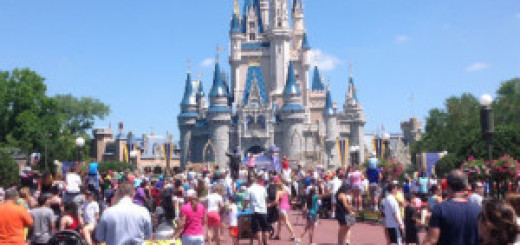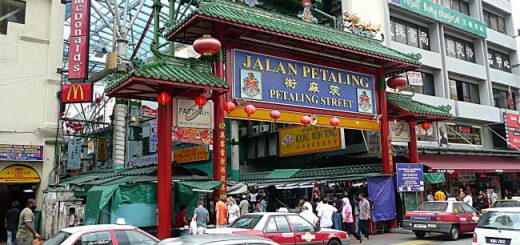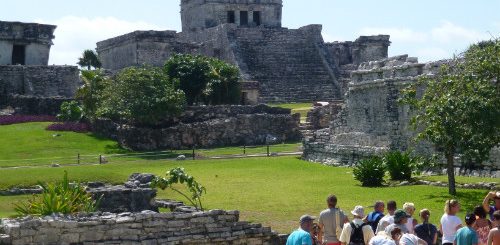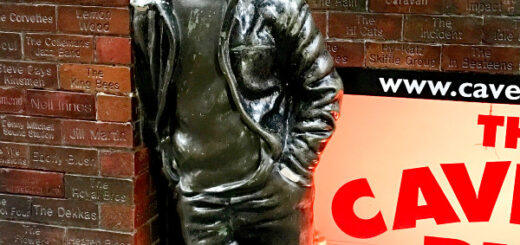Lisbon
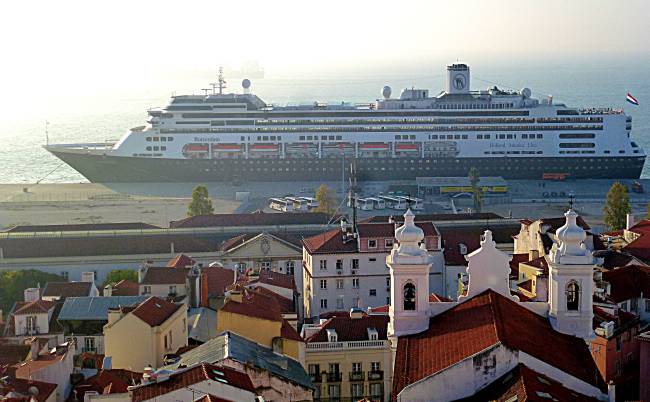
The HAL cruise ship, Rotterdam, docked in the wide estuary of the Rio Tejo (Tagus) right near the Alfama district of Lisbon. From the deck we had great views of the city even before we departed on our tour. The company we used was Specialimo, a hire car company which specialises in private small group tours. We chose the standard half-day tour with a couple of extra points of interest added on, which took it to a 5 hour tour.
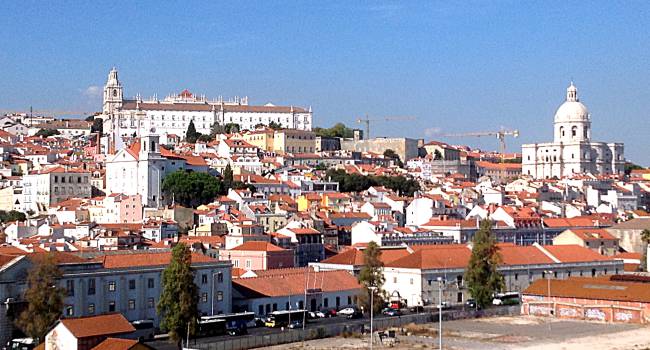
Lisbon is situated on seven hills, so we were keen to reduce the amount of walking by visiting most of it by minibus. Some attractions we saw on foot, but some areas we simply drove through. In all, we saw Castelo de S. Jorge, Rossio, Avenida da Liberdade, Marquês de Pombal, Praça do Comércio, Bairro Alto, various Miradouros (lookouts), Alfama, Belém, Torre de Belém, Padrão dos Descobrimentos (Discoveries Monument), Mosteiro (Monastery) dos Jeronimos, April 25th Bridge and lastly the Cristo Rei statue.
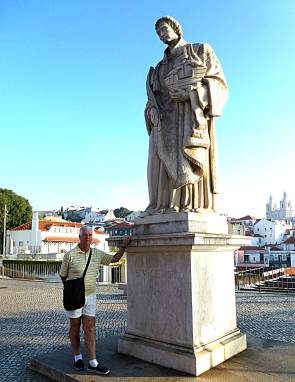
Our driver and tour guide, Paul, picked up our group of eight and took us directly to the Miradouro das Portas do Sol for a view of the river and our ship in the early morning light. This is a popular stop for photographers, with its stunning view from São Vicente de Fora Church to the river. I couldn’t resist taking a photo of Hubby with a statue of his namesake St. Vincent of Saragossa (the city’s patron saint) holding a boat with two ravens, the symbols of Lisbon.
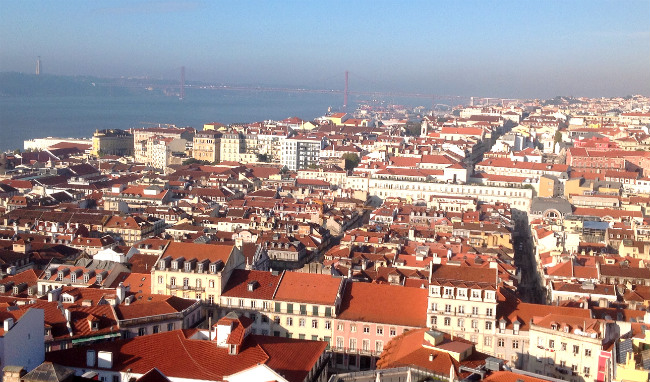
Another great lookout can be found at Castelo de São Jorge, situated at the top of one of Lisbon’s hills. In fact the Camera Obscura housed in the Tower of Riches (or Tumbling Tower) gives tourists 360 degree views of the city.

Although archeological ruins show evidence of settlement here dating back to the 7th Century BC, and a Roman fortification is thought to date from 48BC, the castle as we see it was constructed in the 11th Century by Moorish forces to house their troops as well as the most important members of the community in the event of a siege. These buildings were modified and enlarged during the Middle Ages to contain a palace for the Portuguese kings. Following the earthquake of 1755 substantial renovations converted the citadel into a military installation.
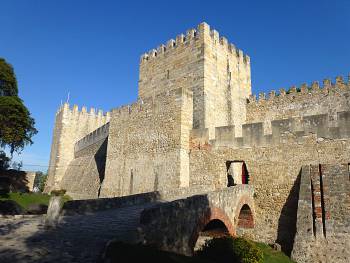
A decree in 1910 declared the site a National Monument, while restoration work from 1938-40 uncovered the earlier palace and castle ruins, allowing for it to be opened to the public. A café, restaurant and exhibition space now occupy some of the restored buildings.

Coming back down the hill we drove through the Alfama district, stopping to visit the Se de Lisboa (Cathedral) which was built in 1147 on the site of a former mosque. It is a mixture of Romanesque, Gothic and Baroque styles, with an austere façade that more closely resembles a fortress.

The main chapel was later decorated in a neoclassical style, while the Gothic ambulatory displays an interesting ceiling of ribbed vaulting with semi-circular clerestory windows.

Next, it was out to the district of Belém to see the famed Monastery of the Jerónimos. Built on the site of the first Santa Maria de Belém church under the direction of King Manuel I (1469–1521), the purpose of the new church and monastery was final resting place for the kings of Portugal as well as a place of spiritual support for the sailors and seafarers who were then venturing out into new lands. Notably, the tomb of explorer Vasco da Gama (1468–1523) is located there.
The monastery was designed in a manner that later became known as Manueline: a richly ornate architectural style with complex sculptural themes incorporating maritime elements and objects discovered during naval expeditions, carved in limestone. The most ornate façade is that of the South Portal of the church, which includes an abundance of gables and pinnacles, with many carved figures standing under a canopy in carved niches, around a statue of Prince Henry the Navigator standing on a pedestal between the two doors. It is a National Monument and a UNESCO World Heritage site, drawing large numbers of tourists who combine the visit with the Discoveries Monument and the Torre de Belém.
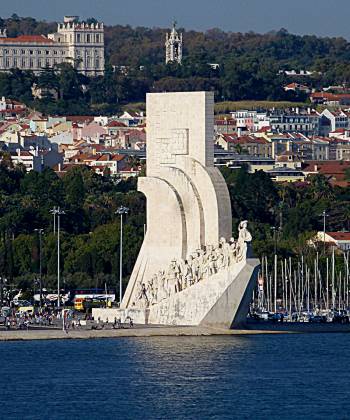
Built on the north bank of the Tagus River in 1960 to commemorate the 500th anniversary of the death of Prince Henry the Navigator, the Monument appears like a three-sailed ship about to set sail across the river.
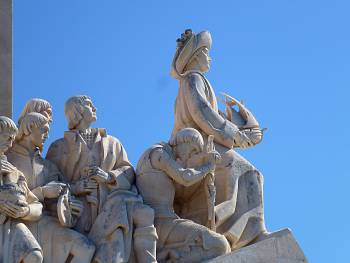
Various personages adorn the monument, such as King Manuel I, Vasco da Gama, Magellan and other explorers, crusaders and cartographers following Prince Henry at the prow. Inside is an exhibition space and an elevator that can take tourists up to a bird’s-eye view of Belém.
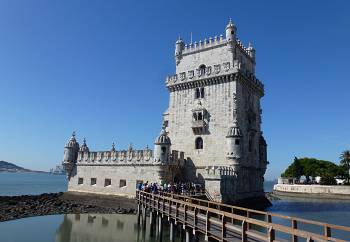
Nearby, The Torre de Belém (formerly the Tower of St Vincent) was built between 1514 and 1520 as part of the Rio Tejo estuary defence system. The fortress was in the shape of a keep, with dungeons in the base and a terrace from where canon could be fired across the river mouth. The upper floors contained the private royal residence featuring a beautiful Italianate loggia with sculpted columns and several balconies with intricate carvings in the Manueline style. Originally in the middle of the estuary, silting of the river now makes access to the tower easy via a boardwalk.
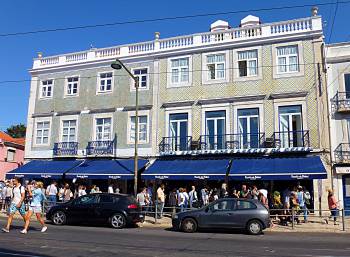
It was in the Mosteiro dos Jeronimos that legend says the nuns invented the wonderful pastéis de nata known here as pastéis de Belém. The shop and café next to the monastery is now world famous, having produced the custard tarts following the original recipe since 1837, with tourists queueing to buy these delectable treats, served and eaten warm straight from the ovens. Our own ‘saint’ Vincent waited patiently in the queue for twenty minutes to secure some for us!
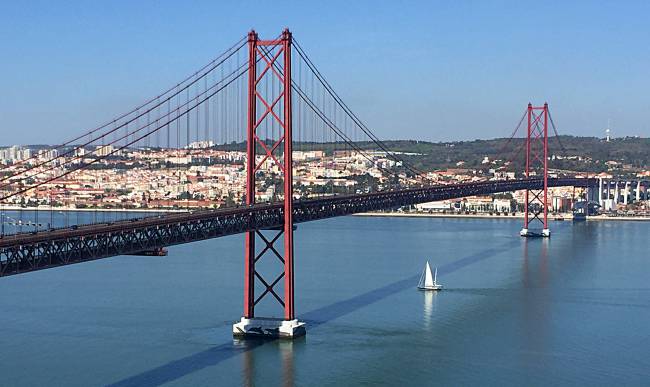
To complete our tour we needed to cross the Rio Tejo via the 25 de Abril Bridge, a steel suspension bridge with an overall length of 2278m and the longest central span in Europe (1013m), longer than San Francisco’s Golden Gate Bridge, which it resembles. Although it was opened as the Salazar Bridge in 1966 – after the then Prime Minister, António de Oliveira Salazar – it was renamed after the revolution of 25 April, 1974. The upper deck carries six car lanes, while the lower deck carries two train tracks which were added in 1999.

The place to get a good view of the bridge is the lookout terrace in front of the Cristo Rei statute, on the Almada side of the river. Inspired by the famous Redeemer statue in Rio de Janeiro, this monument was built in 1959 in thanks to God for sparing Portugal during WWII. Erected on a plateau already 133 metres above sea level, the monument consists of a 82 metre high pedestal, surmounted by a 28 metre figure of Christ, whose arms extend in the shape of a cross to embrace the city across the river. Within the pedestal is the Chapel of Nossa Senhora da Paz (Our Lady of Peace) and elevators that take visitors to an observation deck at the base of the statue.

Finally, our minibus dropped us off back in Lisbon’s main square, the vast Praça do Comércio, so we could have free time to wander around the shops and find a restaurant for a late lunch, before walking back to the ship. Formerly the site of the royal palace until it was destroyed by the 1755 earthquake, the arcaded buildings served as a grand entry to the city through the triumphal arch. Originally housing government offices, the arcades have largely been taken over by restaurants and a modern interactive museum detailing the history of the city. The statue in the middle is of King Jose I on horseback.
Our two wonderful days in Portugal were now sadly at an end, yet we looked forward to re-entry to Spain, via the port of Huelva to the south. For many cruisers this would be their jumping off point to visit Seville, but for us, it was to be a day of independent exploration and golf.
Related articles
- Come with us to Lisbon (veromodame.com)
- travel photographer portugal | lisbon (stefanieharrington.com)
- 36 Hours in Lisbon (trexrunner.com)





